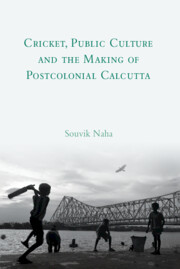Book contents
- Frontmatter
- Dedication
- Contents
- Acknowledgements
- List of Abbreviations
- Introduction
- 1 Cricket, Syndicated Englishness and Postcolonialism
- 2 Narratives of Cricket and Collective History
- 3 The Making of a City of Cricket
- 4 Politicians, Patronage and Centre–State Relations
- 5 Spectators, Gender and Public Space
- 6 The Moral Economy of Violent ‘Gentlemen’
- Conclusion
- Select Bibliography
- Index
Introduction
Published online by Cambridge University Press: 23 November 2022
- Frontmatter
- Dedication
- Contents
- Acknowledgements
- List of Abbreviations
- Introduction
- 1 Cricket, Syndicated Englishness and Postcolonialism
- 2 Narratives of Cricket and Collective History
- 3 The Making of a City of Cricket
- 4 Politicians, Patronage and Centre–State Relations
- 5 Spectators, Gender and Public Space
- 6 The Moral Economy of Violent ‘Gentlemen’
- Conclusion
- Select Bibliography
- Index
Summary
Australian Prime Minister Robert Menzies, in Calcutta (since renamed as Kolkata) on the way to London for the 1951 Commonwealth Prime Ministers’ Conference, was taken by surprise seeing people playing cricket in a country ravaged by colonialism. He said,
When I was driven round Calcutta to my joy I found that on every piece of park lawn people were playing cricket. I pointed to this and said to the gentleman who was accompanying me, ‘well, there you are. There is nothing wrong with this country from anybody’s point of view. Everybody is playing cricket on the park lawns.
What was so special about cricket and why was it so important to a large number of people? ‘Is cricket a sport or a pastime?’ asked an advertisement of the Central Tea Board in India in 1951. There is no pithier one-line encapsulation of cricket’s public history in India. A sport is defined as a structured, goal-oriented, competitive activity, whereas a pastime is a freewheeling indulgence, presumably devoid of conflict, politics and struggle. A letter written by the schoolteacher O. H. T. Dudley to The Times in 1932 shows that Indians might have started to think of cricket as a way of life, more than a pastime, at the turn of the twentieth century. In the letter, Dudley wrote, ‘Twenty-five years ago I went out to India to teach English. I have come back with a rich reward in the following sentence from an Indian schoolboy’s essay on cricket: “Cricket is a very comfortable game: in it we disremember all our condition.”’ In his analysis of the characteristics of Indian cricket in a 1946 book, journalist Berry Sarbadhikary wrote that cricket in India was ‘more of a pastime than a grim science’, referring to the ad hoc nature of the game’s organisation at recreational level and the hybrid cultural attitudes resulting from the integration of Indian and British cultural traditions. When a letter-writer introduced the India–England Test match in Calcutta in 1972–73 as the battle between the bat and the ball that had solved all of Bengal’s socio-political problems, he did not come across as sarcastic but rather entranced by the impact an event spread over five days could have over the long-term woes of a state of 45 million people.
- Type
- Chapter
- Information
- Publisher: Cambridge University PressPrint publication year: 2023



